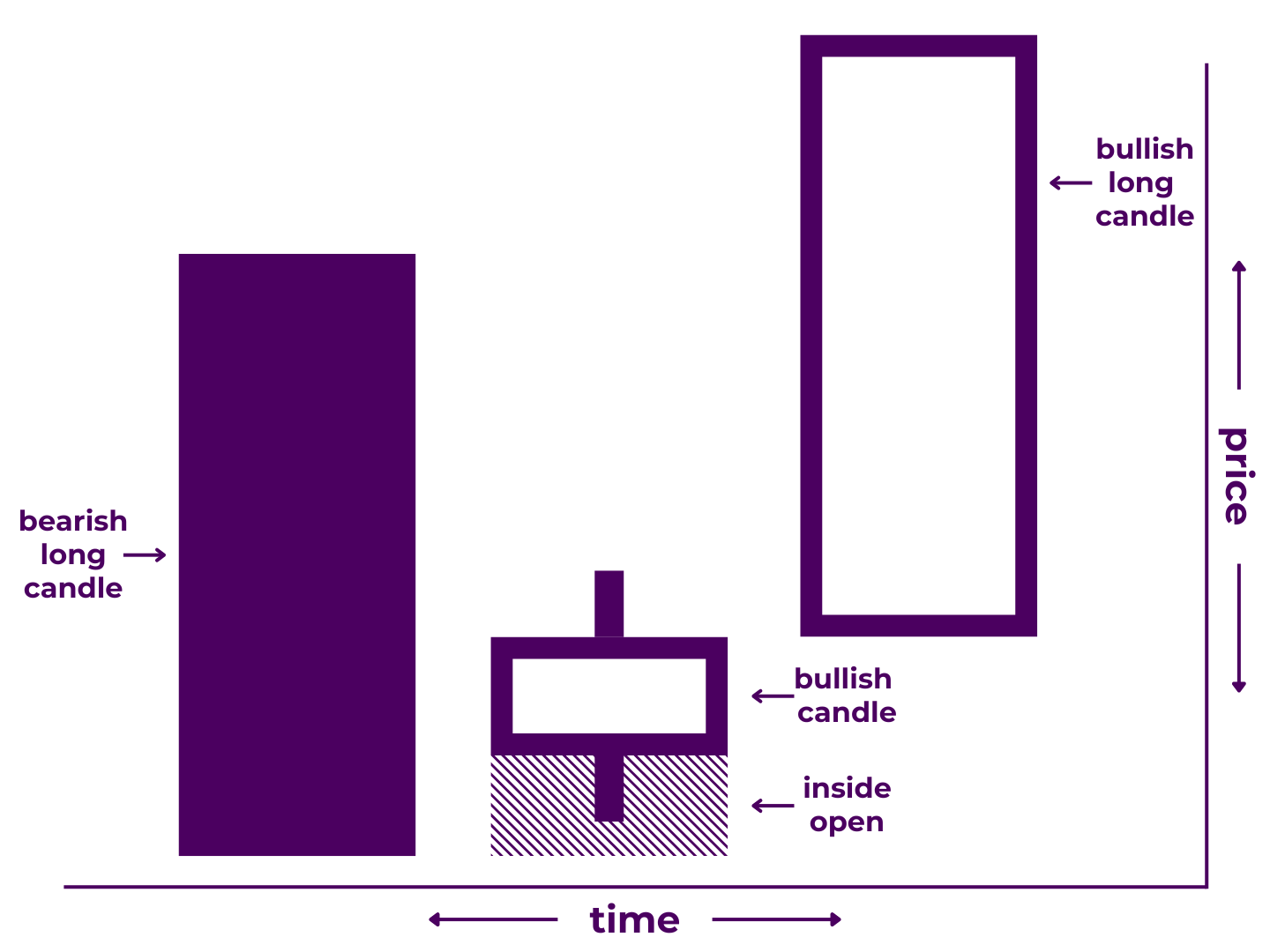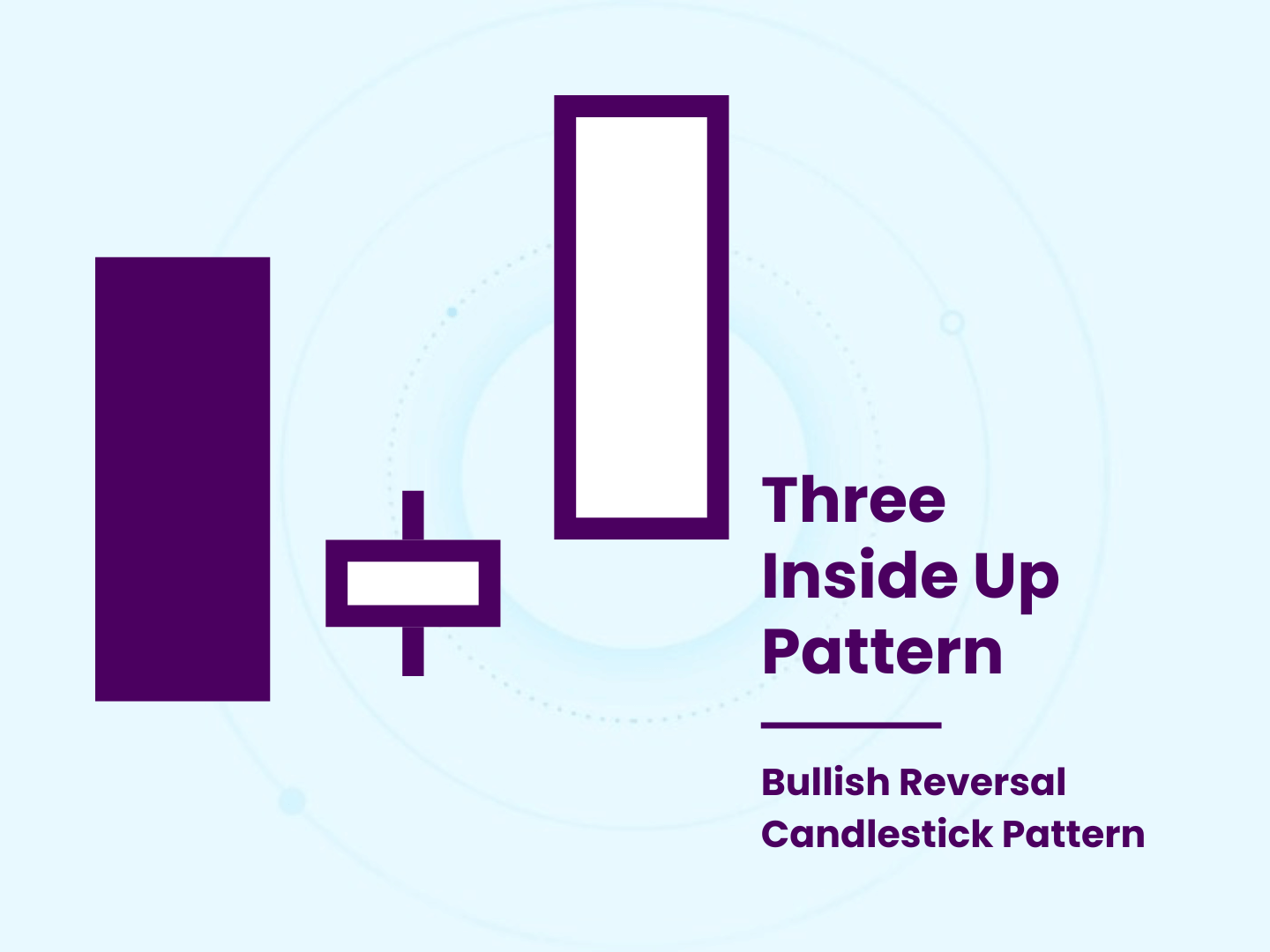Three inside up patterns are fairly rare but give a clear signal.
Since candlesticks are the basic building block of most technical analysis, the ability to recognize different candlestick patterns is a crucial trading skill.
In this Guide to Three Inside Up Patterns, we’ll explain:
First though, let’s start with a definition.
What Is a Three Inside Up Pattern?
A three inside up pattern is a 3-candlestick formation that may signal a reversal. It may appear during a downtrend and is made up of a large bearish candle followed by a shorter bullish (or neutral) inside candle and another bullish candle that closes above the open of the first candle.

It is a subtype of the three inside pattern and the opposite of the three inside down. It is also similar to the three outside up and could even be considered an extension of the bullish harami or bullish harami cross. For all of these patterns, the second candlestick is essentially the apex of the potential reversal.
Of course, no candlestick pattern guarantees a particular outcome. Instead, they offer clues as to what is going on in the market.
So the question is, what does a three inside really tell you?
What Three Inside Up Patterns Mean
Unlike the vast majority of candlestick patterns, the name describes it fairly well.
And unlike some, English speakers do not use the Japanese name for it. It is a three candlestick pattern that includes an inside candle. Thus, “three inside.” Because it implies bullish pressure it’s a three inside “up” (instead of “down”).
(It would be great if all candlestick pattern names were this literal.)
In trading terms:
- During the first period, price continued the pre-existing downtrend.
- Before the second period opened, price moved higher, opening within the range of the prior candle body.
- During the second period, price moved higher to a modest degree, closing within the range of the prior candle body.
- During the third period, price continued moving higher, this time closing above the open of the first period.
This sets the stage for bullish reversal, as it appears the downtrend may be nearing exhaustion.
How To Recognize Three Inside Up Candlestick Patterns
Traders are attracted to patterns partly because they are easy to spot.
However, it’s also easy to see things on the charts that aren’t truly there (or anticipate events that never come to fruition). That’s one of the reasons why waiting for confirmation is so important.
Technically, a three inside up pattern must:
- Appear during a downtrend
- Begin with a bearish long candle
- Have a bullish inside candle as the second candle
- End with a bullish candle that closes above the first candle’s open
In practicality though, many traders will make various exceptions.
- The first candle doesn’t necessarily have to be a long candle, as long as the second candle is a bullish inside candlestick.
- The second candle can be bearish, as long as it is an inside candle.
- The second candle’s wicks don’t necessarily have to be contained within the body of the first, as long as its body is.
- The open of the second candle can be even with the close of the first candle, especially in markets where inside candles are less common, like cryptocurrency.
- There can be more than one inside candle between the first and final candles, as long as the final candle closes above the first candle’s open.
Depending on who you ask, any of these standards may be more or less important. Moreover, some of these variations may be more properly classified as other reversal candlestick patterns, such as the bullish harami or bullish harami cross.
Remember, identifying the reversal itself is more important than labeling the formation. That’s not to say these standards are completely unimportant (as we’ll touch on shortly). It’s just to say that the implications are more important than the criteria.
In other words, you need to put it into context.
Where Three Inside Ups Fit in the Chart Narrative
The markets are often characterized as a battle between the bulls and the bears.
Three inside up patterns show that the bears attempted to press their advantage on candle one, suffered immediate pushback between candles one and two, and completely surrendered momentum over the course of candles two and three.
On the chart, it looks like an emphatic upturn.
It might happen like this on a daily time frame:
On the first day, things were “business as usual” as the bears pushed price significantly lower. Overnight though, the buyers began to push back, leading to an unexpected inside open on the second day. The bulls continued pushing against the downtrend throughout days two and three. Progress was slow at first. Yet by the end of day three, they were able to force price back above the first day’s open.
From here, the bulls look to solidify their hold on the market while bears try to thwart their plans.
In the short-term, it amounts to a counterpunch.
The question traders need to ask themselves is, “Can the bulls make this reversal stick or will it go down as just a blip in the greater downtrend?”
To answer that question, you’ll need more than just an understanding of Japanese candlesticks and candlestick patterns. You’ll want to analyze both within the context of greater chart patterns as well as trend and price levels. You’ll also want to make use of your own chart markup and indicators.
Analyze the history of your preferred asset(s) with respect to three inside patterns and apply it to your own trading style.
Now, you can test (and/or stretch) the criteria we mentioned above to find the most tradeable opportunities. For example, you may find that three inside ups where the third candle is longer than the first candle play out more reliably than those where it isn’t. Or, you may find something else entirely.
Here is where the story in the charts begins to come into focus.
This is what we call technical analysis.
How To Trade Three Inside Up Patterns
Bullish reversal points are great places to enter longs or exit shorts.
Three inside up patterns serve as easy-to-spot signs of potential bullish reversals—and may even lead to longer-term bottoms when found on higher time frames.
Generally, you can put more weight into multi-stick patterns than single candles. They give you more information over a longer amount of time. Still, it is considered unwise to trade based on candlestick patterns alone. They rarely have extremely high hit rates by themselves.
You need additional points of confluence to shift the probabilities in your favor.
Some of the more important ones include:
- Volume – Reversals are often accompanied by elevated trading volume. For three inside ups, be on the lookout for it on the second and (especially) the third candles.
- Price Formations – Three inside ups that form near important support levels are usually more likely to lead to sustained reversals. They may also reinforce the strength of such levels.
- Oscillator Shift – Oscillating indicators like the RSI or stochastics are commonly used to identify reversals by analyzing slope, percentile, and/or divergence.
The fewer such factors corroborating the reversal, the less confident you can be about it.
It would be difficult to form a comprehensive trading strategy around three inside patterns (whether bullish or bearish). There simply isn’t enough there to develop a strong edge. Even with a great understanding of trading math, orders, psychology, risk management, options, and automation, you’d still have a hard time.
You’re much better off building your strategy around other tools then using reversal patterns as an additional point of confirmation.
Patterns like the three inside are much better idea givers than trade makers.
Other Candlestick Pattern Types
The three inside up is but one of many candlestick patterns.
You’d be wise to get familiar with all of the other ones too.
- Abandoned Baby – Bearish | Bullish
- Breakaway – Bearish | Bullish
- Counterattack Lines – Bearish | Bullish
- Doji Star – Evening | Morning
- Engulfing – Bearish | Bullish
- Gap Three Methods – Upside | Downside
- Harami – Bearish | Bullish
- Harami Cross – Bearish | Bullish
- In Neck – Bearish | Bullish
- Kicking – Down | Up
- Ladder – Top | Bottom
- Last Engulfing – Bottom | Top
- Mat Hold – Bearish | Bullish
- Matching – High | Low
- Meeting Lines – Bearish | Bullish
- On Neck – Bearish | Bullish
- Separating Lines – Bearish | Bullish
- Star – Evening | Morning
- Stomach – Below | Above
- Tasuki Gap – Downside | Upside
- Three Methods – Falling | Rising
- Three Outside – Down | Up
- Three-Line Strike – Bullish | Bearish
- Tri-Star – Bearish | Bullish
- Tweezer – Top | Bottom
- Window – Falling | Rising
Sure, there are quite a few of them. But don’t let that intimidate you.
It’s unnecessary to memorize all the names and criteria for every pattern. What’s more important is to learn the principles of price action and technical analysis.
In fact, you’re free to forget all of the names and specifications as long as you can look at a group of candlesticks and understand what they are trying to tell you.
Takeaways
To review:
Three inside ups are a type of candlestick pattern that signals a potential bullish reversal. While not a guarantee, their appearance may indicate that market conditions are changing. Thus, they can help you find winning trades.
Of course, there are other candlestick patterns that you should learn about. And even so, the ability to recognize patterns is not enough to trade successfully on its own.
Nonetheless, you’ve now added one more tool to your toolkit.
Have questions or more information to add? Contribute to the conversation in the comments below! Or, if you know someone who could benefit from this post, share it with them. You can also check out our Candlestick Patterns Guide to improve your candlestick analysis skills.


0 Comments